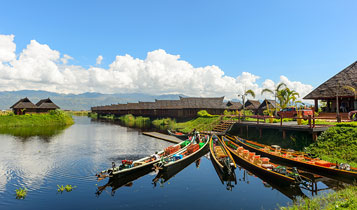


Inle Lake, is a freshwater lake located in the Nyaungshwe Township of Taunggyi District of Shan State, part of Shan Hills in Myanmar (Burma). It is the second largest lake in Myanmar with an estimated surface area of 44.9 square miles (116 km2), and one of the highest at an elevation of 2,900 feet (880 m). During the dry season, the average water depth is 7 feet (2.1 m), with the deepest point being 12 feet (3.7 m), but during the rainy season this can increase by 5 feet (1.5 m).
The people of Inle Lake (called Intha), some 70,000 of them, live in four cities bordering the lake, in numerous small villages along the lake's shores, and on the lake itself. The entire lake area is in Nyaung Shwe township.
Fish caught from the lake - the most abundant kind is called nga hpein locally (Inle carp, Cyprinus intha) - are a staple of the local diet. A popular local dish is htamin gyin - 'fermented' rice kneaded with fish and/or potato - served with hnapyan gyaw (literally twice fried - Shan tofu). In addition to fishing, locals grow vegetables and fruit in large gardens that float on the surface of the lake. The floating garden beds are formed by extensive manual labor. The farmers gather up lake-bottom weeds from the deeper parts of the lake, bring them back in boats and make them into floating beds in their garden areas, anchored by bamboo poles. These gardens rise and fall with changes in the water level, and so are resistant to flooding. The constant availability of nutrient-laden water results in these gardens being incredibly fertile. Rice cultivation and consumption is also significant facet of the local diet and agricultural tradition.
A number of festivals occur from August to October on Inle Lake and in the surrounding areas. The ceremonial Hpaung Daw U Festival, which lasts for a total of 18 days, is closely followed by the Thadingyut festival of lights. Inthas and Shan turn out in their best clothes in great numbers to celebrate the Buddhist Lent. Traditional boat racing, with dozens of leg-rowers in traditional Shan dress compete on teams with a team on each boat. These boat races are locally one of the most anticipated affairs during the Hpaung Daw U Festival.
One of the tourist attractions in the village on the lake itself is the traditional silversmithing, which has fed into the local tourist economy.